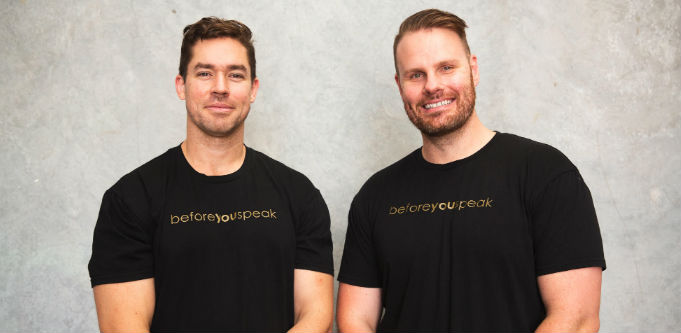
Beforeyouspeak Coffee co-founders Jaryd Terkelsen (left) and Ash Bisset (right). Source: Supplied.
Breaking into a competitive industry can be intimidating for most aspiring small-business owners. But if you’re thinking you need a brand new business idea to be successful, you might want to reconsider. With a solid product, business acumen and a unique market position, sometimes there’s no need to reinvent the wheel.
Sell what customers are already buying — just sell it better than your competition. Here are eight tips to lend a hand.
1. Create your own category within a category
The best thing about breaking into a competitive industry is you know there’s a market for it. But within that broader market, there are always sub-markets.
Take the beauty industry, for example. There are your big Priceline-esque brands that sell to the mass market, and then there are subcategories with organic skincare and natural makeup.
Toilet paper is a household staple, yet with a great story and some clever marketing, toilet paper brand Who Gives a Crap has reinvented the way people think about and shop for toilet paper.
2. Don’t launch without a unique selling proposition
With coffee, we knew Aussies were spoilt for choice. There are many fantastic coffee beans in Australia. But no one had combined coffee with superfoods, and it inspired our unique selling proposition to cater to health-conscious people with a love for coffee. Our growth has come mostly from the fitness industry, but we’ve now ventured mainstream, with the release of a collagen-based coffee, tailored for the beauty industry.
3. Start small
When you’re a growing business, it’s easy to get consumed by doing everything you can to make it a success.
But it’s important to stay focused on the small details, such as delivering the best customer experience at every touchpoint, from purchase and delivery through to the follow-up.
Business is done with people, and building genuine relationships is the key to success. Go above and beyond.
If you continually add more value to your consumers than your competitors, you will win.
4. Collaborate
If you don’t have a large audience to market to, leverage other brands or influencers who do.
Look to partner with non-competing brands that share the same target audience. For example, say you sell yoga mats, you may consider partnering with yoga studios or activewear brands. You might also want to work with influencers, who are often photographed in their yoga poses.
Partnerships are the fastest way to build rapport and trust with your target audience.
5. Be consistent with your branding
When you’re breaking into a competitive industry, consistent brand messaging and content will help people remember your brand. Make sure you have clear brand guidelines and a tone of voice set to ensure your customers get a consistent brand experience.
6. Listen, a lot
The upside of being a startup is that you can be agile. You can make changes quickly. Your first launch may not always be a winner, but it’s a starting point to get feedback straight from your customers.
If your product could use tweaking, listen to your customers. They could be the ones helping you get your product from good to great.
Take their feedback onboard, optimise and launch again.
7. Consider the whole buying cycle
Getting your customers to purchase from you is only the start of your journey. Given you give your customers a great experience, they’re more likely to purchase from you in the future. It’s critical for brands to have a strategy that considers how you’ll retain current customers and have them purchase from you again and again.
Have a strategy from the top of the funnel through to the bottom of the funnel and retention, as you build the relationship and take your consumers through the buying cycle.
8. Never stop learning
Regardless of how much you’ve grown as a business, there is always room to learn from others.
Some great books that have helped us along the journey are:
- Influence, by Dr Robert Cialdini;
- Pre-Suasion, by Dr Robert Cialdini;
- Tell to Win, by Peter Guber;
- Blink, by Malcolm Gladwell;
- The Sticking Point Solution, by Jay Abraham; and
- The Brain Audit, by Sean D’Souza.
Most of these books are available in audio, so if you don’t have time to read, you can listen to them on your commute.
NOW READ: How we did it: Eight entrepreneurs on the emotional rollercoaster of crowdfunding


COMMENTS
SmartCompany is committed to hosting lively discussions. Help us keep the conversation useful, interesting and welcoming. We aim to publish comments quickly in the interest of promoting robust conversation, but we’re a small team and we deploy filters to protect against legal risk. Occasionally your comment may be held up while it is being reviewed, but we’re working as fast as we can to keep the conversation rolling.
The SmartCompany comment section is members-only content. Please subscribe to leave a comment.
The SmartCompany comment section is members-only content. Please login to leave a comment.